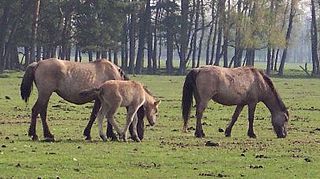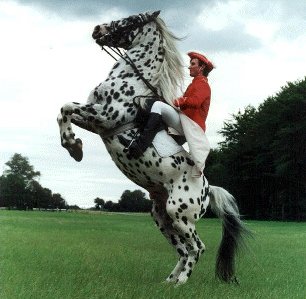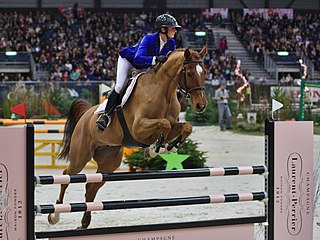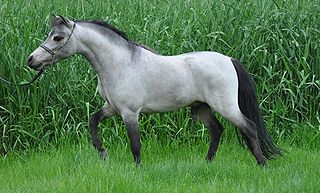
The Dülmener or Dülmen is a German breed of small feral horse. It was formerly known as the Merfelderbrücher. A herd of approximately 300 head lives in feral conditions in an area of about 3.5 km2 in the Merfelder Bruch, near the town of Dülmen in the Kreis of Coesfeld in north-western Nordrhein-Westfalen, in north-western Germany.

The Appenzeller Sennenhund is a Swiss breed of medium-sized working dog. It originates in the Appenzell region of north-eastern Switzerland, and is one of four regional breeds of Sennenhund or Swiss mountain dog, all of which are characterised by a distinctive tricolour coat.

The Knabstrupper or Knabstrup is a Danish breed of warmblood horse. It is principally a riding horse, but is also used as a harness horse and as a circus animal.

The Freiberger or Franches-Montagnes is a Swiss breed of horse of light draught type. It originates in the Canton of Jura in north-western Switzerland, and is named for the Freiberge or Franches-Montagnes District in the south of that canton. It is widely distributed in Switzerland, and is also present in France and Belgium.

The Swiss Warmblood or Schweizer Warmblut is a modern Swiss breed of warmblood sport horse. It was created in the mid-twentieth century by merger of the Einsiedler – which had been bred for centuries at the Benedictine Monastery of Einsiedeln in the Canton of Schwyz – with the Swiss Halfblood and with traditional local breeds including the Ajoie, the Erlenbacher and the Entlebucher. It is sometimes known as the Neue Einsiedler. The Swiss Warmblood is bred at the Haras National Suisse at Avenches, in the Canton of Vaud.

The Rottaler is a German breed of riding and carriage horse of heavy warmblood type. The name derives from that of the Rottal, the valley of the Rott in the Landkreis of Rottal-Inn in south-eastern Bavaria. It is critically endangered. The Bavarian Warmblood derives from it.

The Appenzeller Spitzhauben is a Swiss breed of crested chicken originating in the historical Appenzell region of Switzerland. It is one of two chicken breeds from that area, the other being the Appenzeller Barthuhn; the only other Swiss breed of chicken is the Schweizer.

The Valais Blackneck is a breed of domestic goat from the canton of Valais, in southern Switzerland, and neighbouring areas of northern Italy. The largest concentration is in the area of Visp (Viège). It is present in modest numbers in Austria and Germany. It is known by many names, including German: Walliser Schwarzhalsziege or Gletschergeiss; French: Col Noir du Valais, Chèvre des Glaciers or Race de Viège; and Italian: Vallesana or Vallese.
The Azerbaijan, is an Azerbaijani breed or group of breeds of riding horse of Oriental type. In 2007 it was listed by the FAO as endangered; in 2021 it was not among the horse breeds reported to DAD-IS.

The Schweizer, German: Schweizerhuhn or "Swiss chicken", is a Swiss breed of domestic chicken. It was bred in 1905 in Amriswil, in the canton of Thurgau, in north-east Switzerland. It is kept mainly in German-speaking areas of the country. It is one of three Swiss chicken breeds, the others being the Appenzeller Barthuhn and the Appenzeller Spitzhauben.
The Sempione is a rare breed of domestic goat from the mountains of Piemonte in north-western Italy and the neighbouring area of Simplon in the canton of Valais in Switzerland; Sempione is the Italian name for Simplon. The Sempione goat is well documented in photographs from the early twentieth century, but is now thought to be close to extinction, and has more than once been considered extinct. Examples were recorded at Saliceto di Cravagliana in the province of Vercelli in 1983, and others have since been identified in the province of Verbano-Cusio-Ossola, particularly in the Val Divedro and the upper Ossola.

The Chamois Coloured Goat, French: Chèvre chamoisée, German: Gämsfarbige Gebirgsziege, Italian: Camosciata delle Alpi, is an indigenous breed of domestic goat from Switzerland. It is distributed throughout Switzerland and in parts of northern Italy and Austria, and has been exported to other countries including France. There are two strains, a horned type from the Grisons or Graubünden in the eastern part of the country, and a hornless type from the former bezirk of Oberhasli and the area of Brienz and Lake Brienz in the Bernese Oberland in central Switzerland. In some countries the hornless variety may be considered a separate breed, the Oberhasli goat. The Swiss herd-book was established in 1930.

The Capra Grigia, French: Chèvre grise des montagnes, German: Graue Bergziege, is a rare and endangered indigenous breed of domestic goat from Switzerland. It originates in the valleys of the cantons of the Grisons or Graubünden in the eastern part of the country, and of Ticino or Tessin in the south. It is possibly related to the grey type of the Passeirer Gebirgsziege from the Autonomous Province of Bolzano in north-eastern Italy.

The South German Coldblood is a breed of draught horse from southern Germany. It is distributed mainly in Bavaria. It is the most numerous of the four principal German draught horse breeds – the others being the Black Forest Horse, the Rhenish German Coldblood and the Schleswig Coldblood – and is the only one not listed as endangered by the FAO or by the Gesellschaft zur Erhaltung alter und gefährdeter Haustierrassen, the German national association for the conservation of historic and endangered domestic animal breeds.

The Red Engadine or Engadine Red is a traditional Swiss breed of domestic sheep from the Lower Engadine valley and some neighbouring parts of Bavaria and Tyrol. It derives from cross-breeding of stock of Bergamasca and Alpines Steinschaf type. It is characterised by its convex profile, its fox-red wool and its long lop ears. In the 1980s it became gravely endangered, but has since recovered. It is a hardy mountain sheep; the hooves are strong and hard, and the breed is one of the few that are reported to have good resistance to foot rot.

The Rätisches Grauvieh is an endangered Swiss breed of cattle from the Graubünden in eastern Switzerland. It is a smaller type of the Tiroler Grauvieh breed of Alpine grey cattle. In the 1920s it was absorbed into the Braunvieh population. In 1985 the population was re-established by the introduction of cattle of the similar Albula type from Austria. Like the Rhaetian Alps, it is named for the Ancient Roman province of Rhaetia.

The American Miniature Horse is an American breed of small or miniature horse. It has been selectively bred to display in miniature the physical characteristics of a full-sized horse, and usually stands no taller than about 38 in (97 cm). It frequently has the appearance of either a small Arab or a small draft horse; genetically it is no different to pony breeds such as the Shetland.

The Appenzeller Barthuhn is a Swiss breed of bearded chicken originating in the historical Appenzell region of Switzerland. It is one of two chicken breeds from that area, the other being the Appenzeller Spitzhauben; the only other Swiss breed of chicken is the Schweizer.

The Einsiedler or Einsiedeln is a historic Swiss population or breed of warmblood horse with roots going back to the eleventh century. It was – and still is – bred at the Benedictine Abbey of Einsiedeln in the Canton of Schwyz, and is sometimes known as the Cavallo della Madonna. In the mid-twentieth century the stud-book was discontinued and the Einsiedler was merged with the Swiss Halfblood and with traditional local breeds including the Ajoie, the Erlenbacher and the Entlebucher to create the Swiss Warmblood, a modern sport horse. Although it is reported to be extinct, the traditional type is still bred at the abbey; there are perhaps a hundred of them in all, with fewer than ten foals born each year.



















